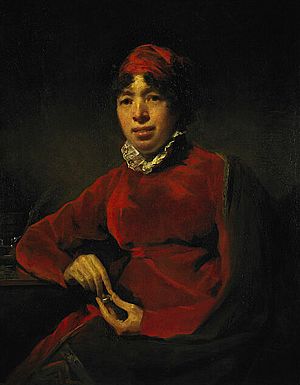Elizabeth Hamilton (writer) facts for kids
Quick facts for kids
Elizabeth Hamilton
|
|
|---|---|

Portrait of Elizabeth Hamilton, 1812, by Sir Henry Raeburn.
|
|
| Born | 25 July 1756 Belfast, Ireland |
| Died | 23 July 1816 (aged 59) Harrogate, England |
| Occupation | Essayist, poet, novelist |
| Language | English |
Elizabeth Hamilton (born in 1756 or 1758, died July 23, 1816) was a Scottish writer. She wrote essays, poems, and novels. She was known for discussing important ideas about how girls and women should be educated. She also wrote about women's rights during a time of big changes, like the French Revolution.
Contents
Early Life and Education
Elizabeth Hamilton was most likely born on July 25, 1756. Some records say 1758, but 1756 is more probable. She was born in Belfast, which is in Ireland. She was the youngest of three children. Her father, Charles Hamilton, was a Scottish merchant. Her mother was Katherine Mackay.
Elizabeth's parents knew many important "New Light" Presbyterian families in Belfast. These families had modern ideas from the Scottish Enlightenment. This was a time when people focused on reason and new ways of thinking.
Elizabeth's ideas about teaching children were shaped by David Manson's school. This school taught both boys and girls together. Elizabeth's older sister, Katherine, went there. Manson believed in teaching children without harsh punishments. He wanted learning to be fun and healthy.
In 1762, after her father passed away, Elizabeth went to live with her aunt. Her aunt, Mrs. Marshall, lived near Stirling in Scotland. In 1772, Elizabeth lived at Ingram's Crook, close to Bannockburn.
A Writer's Journey
Elizabeth Hamilton started her writing career by helping her brother, Charles. He was studying Eastern cultures and languages. After he died in 1792, she kept publishing her own works. These included writings about Eastern studies, history, and education. She also wrote about different theories.
Elizabeth stayed in touch with her friends in Belfast. She became very close with Martha McTier. Martha was the sister of William Drennan, who started the United Irishmen group. Martha McTier was a pioneer in setting up schools for poor girls.
In 1793, Elizabeth visited Martha in Belfast. She was very impressed with Martha's teaching methods. Martha proudly said that her young students could read well. They could even read speeches by famous politicians like Fox and Pitt.
Exploring New Cultures
In 1796, Elizabeth Hamilton published a two-volume book called Translation of the Letters of the Hindoo Rajah. This book was similar to works by famous writers like Montesquieu and Goldsmith. It told the story of an Indian prince visiting England.
The prince met slave owners, rich people who were not always fair, and philosophers who doubted everything. He also met women who were very strong-willed. As he saw more of English culture, he became less and less impressed with it.
Ideas on Education and Women
In 1800, Hamilton wrote Memoirs of Modern Philosophers. This novel was her response to the "Revolution Controversy" of the 1790s. This was a big debate in Britain about new ideas. People discussed things like who should be allowed to vote, how property should be passed down, and rules for marriage and divorce.
Some people, like Hannah More, believed that men and women had different ways of thinking. Others, called "Jacobins" by their critics, like Mary Wollstonecraft, argued that women were only limited by poor education.
In her novel, Elizabeth Hamilton seemed to take a middle path. She strongly supported better education for women. However, she also believed that women should focus on their homes and families. She thought this should be guided by Christian, middle-class values.
Hamilton's most important books about education came out after this. These included Letters on Education (1801) and Letters on the Elementary Principles of Education (1801). She also wrote Letters addressed to the Daughter of a Nobleman, on the Formation of Religious and Moral Principle (1806). Her last big educational work was Hints addressed to the Patrons and Directors of Schools (1815).
Stories of Scottish Life
In 1808, Elizabeth Hamilton wrote The Cottagers of Glenburnie. This was a very popular story about Scottish life and customs. It looked closely at the difficulties and unfairness that women faced in their daily home lives.
The book also included a long discussion about how children should be educated. In the story, characters named Mr. Gourley and Mrs. Mason help a teacher, William Morrison. They guide him to set up his school in a new way. This system used older students to help teach younger ones. It focused on responsibility and self-control, without using harsh punishments.
Mrs. Gourley mentions David Manson's "play school." In a note, Hamilton also praised Manson. She felt his amazing talents were not noticed enough because he worked in a small area in Belfast.
Elizabeth Hamilton spent much of her later life in Edinburgh, Scotland. She passed away in Harrogate, England, in 1816, after a short illness.

